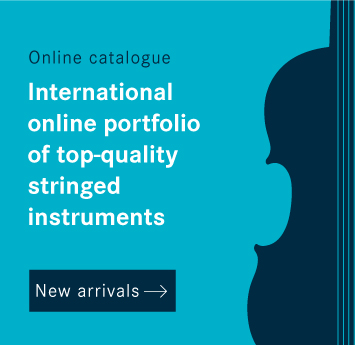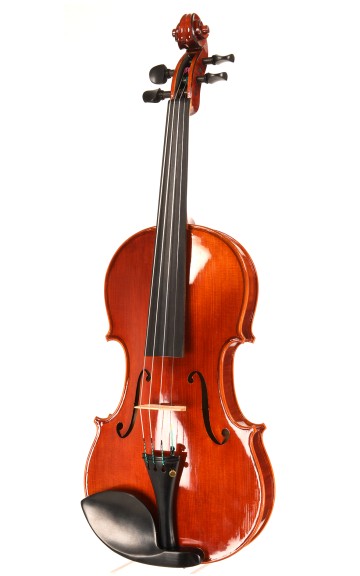Violin making in Florence is one of the most enigmatic chapters in the history of Italian craftsmanship, because although musical life flourished in the city of the Medici - which was one of the most important cultural centers in Europe in its heyday - no independent local violin making tradition developed in Florence. Although many Florentine liutai are well known by name, they have left little more evidence of their work than the occasional repair note on instruments made by other masters.
Overview:
- The violin makers of Florence in the shadow of Brescia and Cremona
- The beginnings of violin making in Florence
- Important violin makers in Florence in the 17th and 18th centuries
- Families in classical Florentine violin making
- Violin making in Florence in the 19th and 20th centuries
- Florentine violin making today: family and workshop relationships
- The violin makers of Florence in the shadow of Brescia and Cremona
This finding corresponds to the situation in other Italian cities and most probably reflects the outstanding success of the famous workshops in Brescia and Cremona, which are of historical importance not only because of their contributions to the development of the violin model that is still valid today. In fact, the Amati, Stradivari and Guarneri families and others from their sphere of influence dominated the market for new instruments and supplied sacred and secular patrons throughout Italy and beyond.
It can therefore be assumed that Florence offered numerous violin makers a good livelihood, certainly including first-class masters - and probably in greater numbers than research has so far focused on.
The beginnings of violin making in Florence
As little as a classical violin-making tradition developed in Florence, the information about the beginnings of the craft in the city is equally sparse. While some authors credit the proverbial universal genius Leonardo da Vinci with founding violin making in his home town, others assume that Valentino Siani (1595-1672) was the first liutaio in Florence to make instruments of the violin family alongside the traditional plucked instruments. Valentino Siani's instruments, of which only a few are known, display a mature, individual style influenced by his probable teacher Giovanni Paolo Maggini. Valentino Siani's instruments are still valued today for both their craftsmanship and their tonal quality.
Important violin makers in 17th and 18th century Florence
The contemporary violin makers alongside Siani included not only outstanding masters of their art, but also Giovanni Battista Doni (1595-1647), a multi-talented and influential figure in music history. The scholar and musicologist is not only known as the creator of the Do-Re-Mi - by replacing the Ut in the solmization with Do, in the sense of better singability, praise of the Creator (dominus) and perhaps also the memory of his own family name - but also as the first opera theorist and innovative instrument maker who invented the lyra barberina (amphicord). And although no violins by Giovanni Battista Doni have survived, there is no doubt about his special appreciation of the modern violin: "Among all musical instruments, the nature of the violin is truly wonderful", he makes clear in his Annotazioni sopra il Compendio de' Generi e de' Modi della Musica of 1640, because "in the hands of an experienced player, the violin combines the softness of the lute, the sweetness of the viola da gamba, the majesty of the harp, the power of the trumpet, the liveliness of the pipe, the plaintiveness of the flute, the pathos of the cornet". Giovanni Battista Doni's family probably also included Rocco Doni, who was one of the most productive and respected violin makers of his time.
 Another shining figure in Florentine violin making is Bartolomeo Cristofori (1655-1731), who has gone down in music history as the inventor of the fortepiano, but who - despite some historical questions about his biography that have not yet been clarified - most probably also made stringed instruments. The cellos and a double bass that have survived under his name present an excellent master with an independent artistic signature, whose work was already held in the highest esteem during his lifetime. The latter is evident from a repair label attached to a Cristofori cello by none other than Antonio Stradivari.
Another shining figure in Florentine violin making is Bartolomeo Cristofori (1655-1731), who has gone down in music history as the inventor of the fortepiano, but who - despite some historical questions about his biography that have not yet been clarified - most probably also made stringed instruments. The cellos and a double bass that have survived under his name present an excellent master with an independent artistic signature, whose work was already held in the highest esteem during his lifetime. The latter is evident from a repair label attached to a Cristofori cello by none other than Antonio Stradivari.
The fact that several violin makers from Germany moved to Florence early on in the 17th century and established teacher-pupil relationships that have only been rudimentarily researched to date also speaks to the high demand for violin making services in the city. Well-known names include Filippo Zimbelmann, who probably worked for Giovanni Suover before opening his own workshop. Wilhelm and Melchior Eberle, whose work in Florence is documented from 1603 onwards, and their contemporary and presumed relative Bartolomeo Eberspacher came from Hofen near Wald in the Allgäu.
Families in classical Florentine violin making
The fact that violin makers enjoyed good working conditions in Florence is also demonstrated by the various families of violin makers in which the craft flourished over several generations, particularly in the 17th and 18th centuries.
The Gabrielli dynasty of violin makers, for example, included four masters, of whom Giovanni Battista Gabrielli (1716-1771) was already the most famous during his lifetime. With his style-conscious, experimental and Jakob Stainer-oriented way of working, the best results of which have been preserved in the viola and violoncello subjects, Giovanni Battista Gabrielli made a good name for himself, which many a dealer had printed on false labels for a long time to come.
Of the nine known members of the Carcassi family of violin makers, with whom the beginnings of a regional "Tuscan school of violin making" are indeed tangible, Lorenzo Carcassi (- ca. 1776) is considered the most distinguished and still highly esteemed master, who worked both under his own name and in cooperation with his brother Tomaso Carcassi (- ca. 1786) under the firm "Lorenzo e Tomaso Carcassi" from ca. 1745. Their work represents the influence of Jakob Stainer's violin model in northern Italy.
Violin making in Florence in the 19th and 20th centuries
Productive and influential families of instrument makers were also active in Florence in the 19th century, first and foremost among them the name Castellani. Although, like many Italian liutai, they devoted themselves at least as much to making guitars and mandolins, the Castellanis also produced very good violins in their workshops. Their most important representative was Luigi Castellani (1809-1884), who had learned his craft from his father Pietro Castellani (1780-1820) and later ran the Castellani e Figlio workshop. Thanks Luigi Castellani's excellent reputation as a restorer, he was appointed to the Florentine Conservatory. In 1866, Luigi Castellani recruited none other than Giuseppe Scarampella (1838 - ca. 1885) to work in his flourishing business, which was taken over by Pietro Ballerini after his death.
Another outstanding violin maker in 19th century Florence was Lorenzo Arcangioli, who was very successful in the first half of the century in reviving the old Italian violin making tradition and the Tuscan school. Valentino de Zorzi (1837-1916) was a highly innovative violin maker who was self-taught in his craft and came to Florence from Pistoia in 1885. His work followed a personal violin model - an interesting synthesis of Stradivari and Stainer's construction principles - and earned him several awards, while inventions such as an 18-string "harp guitar" and a "contraviolino" are an expression of his enormous creativity and interesting, experimental contributions to the violin making of his time.
The 20th century brought a breath of fresh air to Florentine violin making, which is inextricably linked with the name Bisiach. Born and raised in Milan, trained by his father Leandro Bisiach and Léon Mougenot in Mirecourt, by Eugène Sartory in Paris and Karel van der Meer in The Hague, Carlo Bisiach moved to Florence in 1922. At the same time, Iginio Sderci, one of the best employees of the Milan Bisiach workshop, who, like Carlo Bisiach, was strictly committed to the old Italian masters, followed the same path. Iginio Sderci and Carlo Bisiach worked closely together in Florence and were already regarded as leading exponents of Italian violin making of their era during their lifetimes.
Sderci left his mark on violin making in Florence and beyond, not least through his many students, among whom are highly interesting masters such as Leandro Bisiach jr, Giuseppe Bargelli and Roberto Ignesti.
Florentine violin making today: family and workshop relationships
Even today, Florence is a cultural city with international appeal, so it is not surprising that it is home to an interesting and extensive violin making scene. One of its formative influences is the Vettori family, to which 6 violin makers alone belong and in whose workshops important personalities of contemporary Florentine violin making were trained. This important family tradition was founded by Dario Vettori, who gave up his profession as a violinist in 1935 at the age of 30 to devote himself to violin making. Like him, his sons Carlo Vettori and Paolo Vettori went on to become excellent restorers and multi-award-winning liutai. Paolo's children Dario, Sofia and Lapo Vettori now work together with their father and maintain the company's specialization in working with rare, old tonewoods.
The Vettoris' intensive workshop relationships include Paolo's connections with the workshops of the Sderci family, Giuseppe Stefanini and Lapo Casini, from whom he drew significant inspiration, as well as students such as Fabio Chiari, who, in addition to his own highly successful work, has written several specialist books and founded the "Scuola die Liuteria Toscana 'Fernando Ferroni'" in 2014 - a milestone in the recent history of Florentine violin making. His workshop "Liuteria Toscana" alone currently brings together 16 other violin makers, and yet only represents a part of violin making in Florence, where masters such as Claudio Arezio, Tommaso Pedani, Paolo Sorgentone, Michele Mecatti, Fabrizio Di Pietrantonio, Francesco Tarchi and Jamie Marie Lazzara allow countless rewarding explorations into a flourishing craft.




